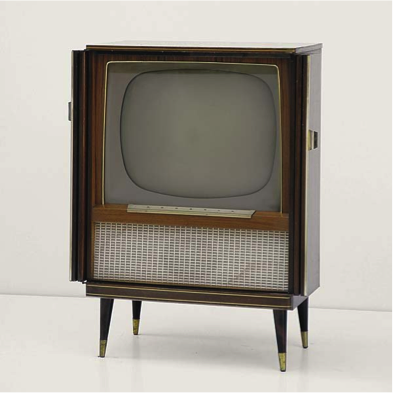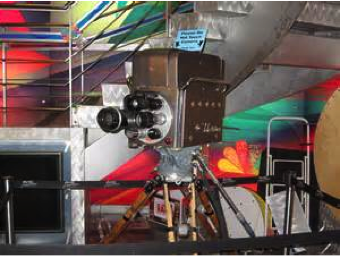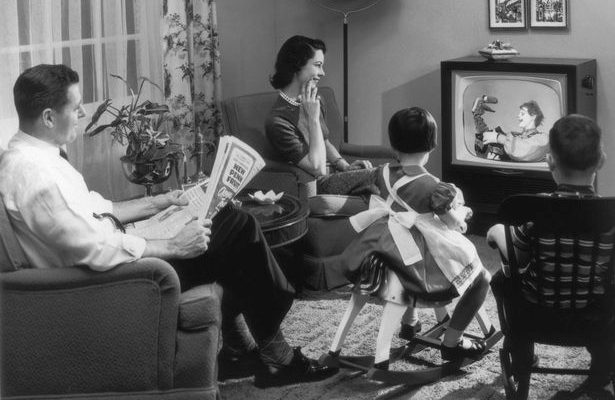Lizzie Goes on Wheeling TV and Stands Up for Sightless Folks
Of all the remarkable things that the remarkable sightless Lizzie Minns did in her remarkable life from raising a sighted daughter and becoming a master baker to maintaining her own Wheeling-based telemarketing sales business and mastering the intricacies of crocheting fancy lace for doilies, hankies and pillowcases, nothing captivated onlookers more than her ability to thread a needle—in her mouth using only her tongue.

She couldn’t remember when she discovered and perfected the technique. It could have been during her very early days spent in a farmhouse at her mama’s side where she learned a wide range of household chores, or at the School for the Blind at Romney, W.Va., or some time and place before or after, but somewhere along the line she picked up the skill. Some folks saw it is a good parlor trick, but Lizzie came upon the ability out of necessity and she considered it just another step in making do for her family.
Her daughter, Mabel, and the rest of the family watched her do it routinely for so many years that they were amused at outsiders’ fascination with the process. She would rock gently in her big, gold-covered, upholstered platform rocking chair, unspool a length of thread from any one of a dozen wooden spools she plucked from inside her little wooden sewing box, and stick one end of the unspooled thread in her mouth. Then, after selecting the correct gage of needle for the job at hand, she would place the end with the eye in her mouth.
What followed was a kind of dexterity that no one could see because it occurred inside Lizzie’s mouth. With tightly closed lips and a look of focused concentration on her face, she manipulated the thread through the eye of the needle using her tongue. It didn’t take more than a few moments before she would take the threaded needle out of her mouth and begin her sewing task—usually hemming pants or a skirt or patching the knee holes on a little boy’s play pants.
So, she and Mabel were particularly surprised and confused when, one day in the late 1950s, a television reporter called with a strange request. Somehow, somebody talked to somebody about Lizzie’s little trick until the reporter got wind of it. He invited her to come on the noon broadcast of the local TV station’s news program and demonstrate her needle and thread expertise live on the air.
Lizzie’s first reaction was typical—a wag of her grey-haired head and a vocal guttural expression of how ridiculous the idea was. But, then she thought about it. She and her late husband, Tom, always had a head for business, and she began to develop one of her frequent gut feelings that this TV thing could be something she could use to enhance awareness of her business. The invitation could be a chance to help her put a face and personality to the voice that her customers heard on her telephone cold calls to sell brooms, mops and other products made by blind people, especially if she had the chance to mention her little business during the interview part of the appearance.

So, one rainy morning with one grandson, 10-year-old Terry, safely off to school and the second, 3-year-old Gerry, at home with a neighbor, Lizzie took Mabel’s elbow and was led out to the family’s Nash for the drive into downtown Wheeling from the family’s Elm Grove cape cod house for her television debut. The television station was on the second floor of an old Market Street building.
“Aren’t you nervous, Mama?” Mabel asked as they climbed the long wooden staircase for their broadcast.
“Of course not, Mabel,” Lizzie responded. “It’s just another conversation and just another needle to thread. Then again, I can’t see all the things in there that apparently make you nervous.”
A young man met them at the top of the stairs who explained that he was the producer of the noon news program.
“You are a bit early but come on in,” he said addressing Mabel. “Would she like a cup of coffee? Would she like to sit over here?”
He gestured toward Lizzie when he launched each of his questions.
Lizzie was irritated at the young man’s persistence in directing his questions about her to Mabel but she bit her tongue and took a seat and sipped the coffee she was given while waiting her turn to enter the studio.
Mabel and Lizzie had a well-known reputation for two things: They were extremely friendly and polite to friends and strangers alike, and they had no tolerance for the way sighted people sometimes treated blind people out of their own ignorance. The folks at the Wheeling television station were about to see a demonstration of the second behavior—right along with the thousands of people in the Ohio Valley who tuned in for the noon news that day.
“Okay,” the young man finally said. “It’s time. They need us in the studio.”
Lizzie arose anticipating Mabel’s offered elbow for her to grab and follow. Instead, the young man committed the cardinal sin of grabbing her arm and tugging her toward the studio. Lizzie’s dander was up and she jerked her arm out of the grasp of the harried young producer.
“Mabel,” she called out gruffly.
“Here Mama,” Mabel responded bumping the harried young man out of the way and making her elbow available for Lizzie to grab.
The young producer was startled by the turn of events but remained dedicated to the time-sensitive chore at hand and urged Mabel to follow him into the studio. Inside, he directed Mabel to take the empty seat furthest away from the already seated anchor and asked Lizzie to sit in the center seat.
The floor manager called out, “back in seven, six, five…” then he used finger signals to count down four, three, two and pointed at the anchor on one.

“Welcome back,” said the smooth-talking anchorman as he looked directly into the camera. “We are happy to have Mrs. Elizabeth Minns and her daughter, Mabel, with us today. Mrs. Minns has a rather unique talent that we thought you at home might like to see. Mrs. Minns, who is blind, can actually thread a needle in her mouth using only her tongue. We also understand she can also use a dial telephone, type on a typewriter and even bake bread. Mabel, tell us a little bit about how your mother can do these things.”
A red light on a second studio camera came on. Mabel, who never expected to even be on the set, froze.
Meanwhile, Lizzie, the gentle, usually quiet, and kind woman who would spend hours in the middle of the night massaging her little grandson’s infection-ravaged painful knee to make him feel better, or play old hymns by the hour on the family’s foot-pump organ, or knit into the early morning hours to complete a gift for a sick friend, had enough.
“I’ll answer that,” Lizzie said quickly. “First, young man, I’m blind, not deaf. If you want to know what I want, think, need, or can do, ask me and I’ll tell you. Secondly, never grab and pull at a blind person like your young man did to get me in here. Just offer your arm and we will take it and follow. It’s all just a matter of respect. Blind people are not cattle. Third, yes, I can type, talk on a telephone, know my way around a kitchen, and do a thousand other things that you do. My question is, why should all that surprise you?”
The anchor ran a hand over his thickly Brill-creamed hair and looked to his stage manager for help.
“Now, I understand you would like me to thread a needle like I’ve done every day for the past 40 years,” Lizzie continued. “It may be true that it’s a rare skill, so I’d be happy to show you how it’s done. I learned how to do it out of necessity since I couldn’t see and, I wanted to sew. I believe there are things we all can learn to do that seem impossible no matter what the circumstances. That’s the example I want people to see today. So, here goes.”
Lizzie pulled a two-foot long piece of white thread from her pocket and removed a needle from the lapel of her dress. She placed one end of thread in her mouth and did the same with the eye end of the needle. The show’s director ordered a camera operator to zoom in on Lizzie’s face. She accomplished her task quickly and with an ease that Mabel had never seen before. She pulled the threaded needle out of her mouth in less than 10 seconds.
That night, the Griffith/Minns family telephone rang often. Lizzie and Mabel were surprised at how many people had actually seen them on the noon telecast. Their many blind friends were ecstatic at the way the interview went.
“You really told ‘em Lizzie,” said one lady.
“It was about time somebody said something about the way blind people are treated,” said another.
“Nice job,” said their old friend Chris Cerone, the blind piano player/tuner who operated the snack stand at the Ohio County Courthouse and who entertained teenagers in Minns confectionaries throughout South Wheeling 20 years before. “Now how about you and Mabel get back to work and help me with the organization that Tom helped me start. You have been missed.”
Chris was talking about the Sightless Workers Guild, an advocacy club of blind people that formed out of weekly social get-togethers that Tom, Lizzie and Chris hosted in the Minns’ living room beginning in the 1930s.
In 1948, a formal city-wide organization that became the Guild was formed. But, with Tom’s death in 1951 and the loss of George in 1955, Mabel and Lizzie had grown distant from their previously vibrant Guild-based social life as they struggled to cope with new and unfamiliar challenges. Now, Chris was calling them back. As Lizzie’s experience that day demonstrated, there was still much work to be done. The Guild would soon become a focal point of their lives…but that’s another story.


